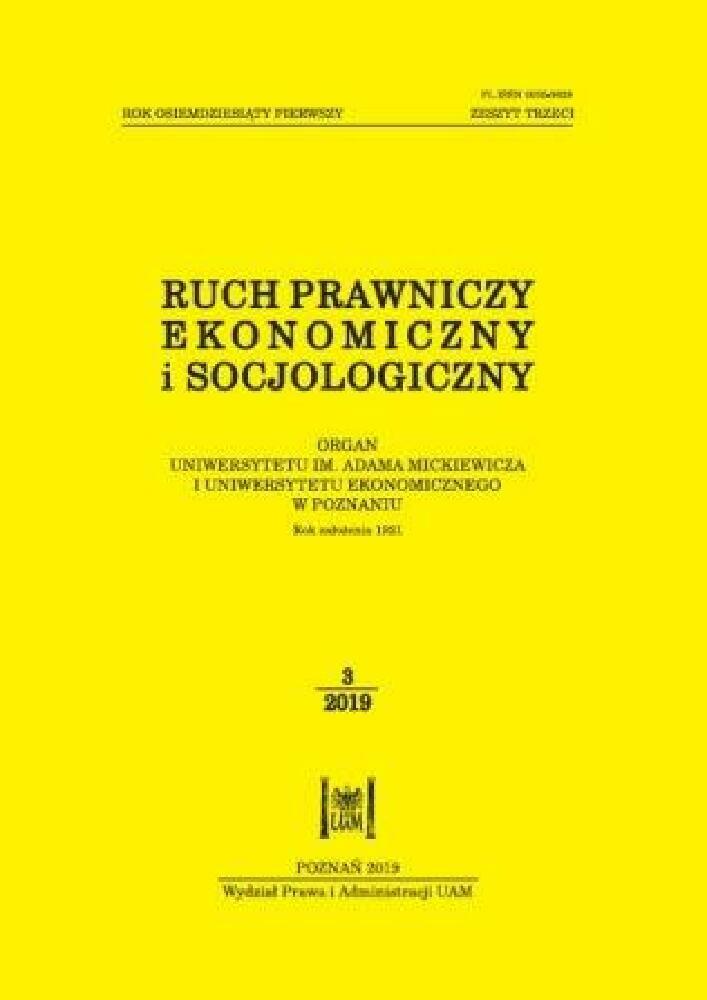Abstrakt
Bitcoinem można obracać na wielu różnych platformach, wykorzystując do tego inne kryptowaluty, jak również waluty tradycyjne. Niemniej jego rzeczywista wymienialność może być ograniczona przez płynność rynku. Głównym celem artykułu jest scharakteryzowanie i porównanie wybranych giełd kryptowalut pod względem płynności. W tym celu przeanalizowano cztery platformy, które odznaczają się wysokim wolumenem obrotu: Kraken, Bitstamp, BitFlyer i BTCBOX, a także dwa małe podmioty umożliwiające handel w polskim złotym: BitBay i BitMarket. W artykule przedstawiono porównanie rynków pod względem liczby zawartych transakcji, średniego czasu pomiędzy kolejnymi transakcjami czy rozkładu wolumenu obrotu w ciągu dnia. Ponadto przeanalizowano zmiany w czasie miary płynności – ILLIQ. Wyniki pozwoliły stwierdzić, że platforma, która znajduje się wśród globalnych liderów w obrocie bitcoinem w danej walucie tradycyjnej, może być postrzegana jako podmiot mały, jeśli zostanie wzięty pod uwagę obrót w innej walucie tradycyjnej. Ponadto najbardziej popularne platformy umożliwiające wymianę bitcoina na polskiego złotego, czyli BitBay i BitMarket, mogą być uznane za rynki lokalne. Są one głównie wykorzystywane do handlu w złotym. W przypadku obrotu bitcoinem w innych walutach tradycyjnych cechuje je bardzo niska płynność. Czynniki takie jak home bias, możliwość handlu bitcoinem w mniej popularnej walucie tradycyjnej (w porównaniu ze światowymi walutami rezerwowymi) oraz interfejs użytkownika w języku polskim mogą dawać pewną przewagę konkurencyjną tym platformom.Bibliografia
Antonopoulos, A.M. (2018). Mastering Bitcoin. O’Reilly Media. https://github.com/bitcoinbook/bitcoinbook [accessed 13 March 2019].
Amihud, Y. (2002). Illiquidity and stock returns: cross-section and time-series effects. Journal of Financial Markets 5: 31–56.
Azzi, G., Bouri, E., Hagfors, L.I., Molnár, P., Roubaud, D. (2017). On the hedge and safe haven properties of bitcoin: is it really more than a diversifier? Finance Research Letters 20: 192–198.
Baur, D.G., Hong, K., Lee, A.D. (2018). Bitcoin: medium of exchange or speculative assets? Journal of International Financial Markets. Institutions and Money 54: 177–189.
Będowska-Sójka, B., Echaust, K. (2018). Commonality in liquidity and the dynamics of the liquidity indices: the evidence from the emerging European stock markets. https://www.researchgate.net/publication/325735275 [accessed 22 March 2019].
Bhaskar, N.D., Lee, D.K.C. (2015). Bitcoin exchanges, [in:] D.K.C. Lee (ed.), Handbook of Digital Currency. Bitcoin, Innovation, Financial Instruments and Big Data. San Diego: Elsevier: 559–573.
Bitcoincharts (2019). Exchange volume distribution. https://bitcoincharts.com/charts/volumepie [accessed 27 March 2019].
Black, F. (1971). Toward a fully automated stock exchange. Part I. Financial Analysts Journal 27(4): 25–35.
Brandvold, M., Molnár, P., Vagstad, K., Valstad, O. (2015). Price discovery on bitcoin exchanges. Journal of International Financial Markets. Institutions and Money 36: 18–35.
Brauneis, A., Mestel, R. (2018). Price discovery of cryptocurrencies: bitcoin and beyond. Economics Letters 165: 58–61.
Briere, M., Oosterlinck, K., Szafarz, A. (2015). Virtual currency, tangible return: portfolio diversification with bitcoin. Journal of Asset Management 16(6): 365–373.
Carrick, J. (2016). Bitcoin as a complement to emerging market currencies. Emerging Markets Finance and Trade 52(10): 2321–2334.
CoinMarketCap (2019). 24 Hour Volume Rankings (All Exchanges). https://coinmarketcap.com/exchanges/volume/24-hour/all/ [accessed 27 March 2019].
Dimpfl, T. (2017). Bitcoin market microstructure. https://papers.ssrn.com/sol3/papers.cfm?abstract_id=2949807 [accessed 7 March 2018].
Doman, M. (2011). Mikrostruktura giełd papierów wartościowych. Poznań: Wydawnictwo Uniwersytetu Ekonomicznego w Poznaniu.
European Central Bank (2015). Virtual currency schemes – a further analysis. https://www.ecb.europa.eu/pub/pdf/other/virtualcurrencyschemesen.pdf [accessed 28 November 2018].
Glaser, F., Haferkorn, M., Siering, M., Weber, M.C., Zimmermann, K. (2014). Bitcoin – asset or currency? Revealing users’ hidden intentions. Proceedings of the European Conference on Information Systems (ECIS). Tel Aviv.
Harris, L. (2003). Trading and Exchanges: Market Microstructure for Practitioners. Oxford: Oxford University Press.
Hileman, G., Rauchs, M. (2017). Global Cryptocurrency Benchmarking Study. Cambridge: Centre for Alternative Finance.
Jonker, N. (2018). What drives bitcoin adoption by retailers? Working Paper no. 585. Amsterdam: De Nederlandsche Bank.
Lesmond, D.A. (2005). Liquidity of emerging markets. Journal of Financial Economics 77(2): 411–452.
Loi, H. (2018). The liquidity of bitcoin. International Journal of Economics and Finance 10(1): 13–22.
Moore, T., Christin, N. (2013). Beware the middleman: empirical analysis of bitcoin-exchange risk, [in:] A. Sadeghi (ed.), Financial Cryptography and Data Security. Berlin: Springer: 25–33.
Nakamoto, S. (2008). Bitcoin: a peer-to-peer electronic cash system. bitcoin.org/bitcoin.pdf [accessed 21 December 2017].
Pandey, V.K., Wu, C.Y. (2014). The value of bitcoin in enhancing the efficiency of an investor’s portfolio. Journal of Financial Planning 27(9): 44–52.
Piotrowska, A.I. (2018). Bitcoin. Płatnicze i inwestycyjne zastosowania kryptowaluty. Warszawa: CeDeWu.
Polasik, M., Piotrowska, A.I., Wiśniewski, T.P., Kotkowski, R., Lightfoot, G. (2015). Price fluctuations and the use of bitcoin: an empirical inquiry. International Journal of Electronic Commerce 20(1): 9–49.
Poskart, R. (2017). Giełdy bitcoina w Polsce. Przegląd Nauk Stosowanych 16: 113–125.
Shi, S. (2017). The impact of futures trading on intraday spot volatility and liquidity: evidence from bitcoin market. https://ssrn.com/abstract=3094647 [accessed 3 April 2018].
Teo, E.G.S. (2015). Emergence, growth, and sustainability of bitcoin: the network economics perspective, [in:] D.K.C. Lee (ed.), Handbook of Digital Currency. Bitcoin, Innovation, Financial Instruments, and Big Data. San Diego: Elsevier: 191–200.
Thies, S., Molnár, P. (2018). Bayesian change point analysis of bitcoin returns. Finance Research Letters 27: 223–227.
Trimborn, S., Li, M., Härdle, W.K. (2017). Investing with cryptocurrencies – a liquidity constrained investment approach. SFB 649 Discussion Paper 2017-014.
Yermack, D. (2015). Is bitcoin a real currency? An economic appraisal, [in:] D.K.C. Lee (ed.), Handbook of Digital Currency. Bitcoin, Innovation, Financial Instruments and Big Data. San Diego: Elsevier: 31–43.
Licencja
Prawa autorskie (c) 2019 WPiA UAM

Utwór dostępny jest na licencji Creative Commons Uznanie autorstwa – Użycie niekomercyjne – Bez utworów zależnych 4.0 Międzynarodowe.





